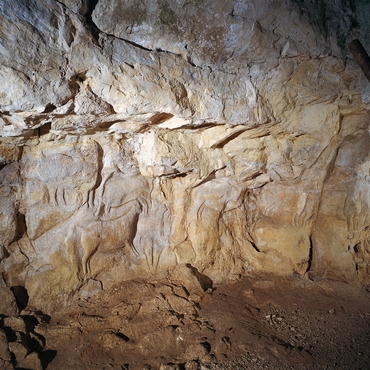
- Home
- Discover the sculptured rock shelters
- Wall sculpture
- Sculpting the wall
- A favourable geological context?
The geological conditions in the Anglin Valley are unique. At Roc-aux-Sorciers, the Jurassic marine limestone cliff was carved out during the creation of the Anglin Valley during the Quaternary. The river cut through the powerful reef formation of the Upper Oxfordian, some forty metres thick, consisting mainly of hard, massive limestone reefs and, in places, soft, homogeneous shelly limestone.
At its base, the cliff consists of a shelly limestone, rich in rolled coral debris and various fossils some 50 cm thick, on top of which is a relatively fine layer of porous, soft shelly limestone that is about 3 m thick. This limestone was originally sand deposited between the reefs. It was modified during its deposit by earthquakes that created structures known as Problematica. They are clearly visible today on the flank of the ibex (Bo4) in the wake of weathering of the carved wall. Above, some 20 metres tall, is a limestone cliff with hard to very hard recrystallized corals, which form the bulk of the cliff.
The exposure of the cliff provided an excellent occupation site, sheltered from the north winds. The presence of an unbroken 3-metre high layer of fine, soft and homogeneous shelly limestone at the foot of the cliff was the determining factor for the realization of the great frieze in the Bourdois Shelter at Roc-aux-Sorciers, and for the sculptures on the ceiling of the Taillebourg Cave.


